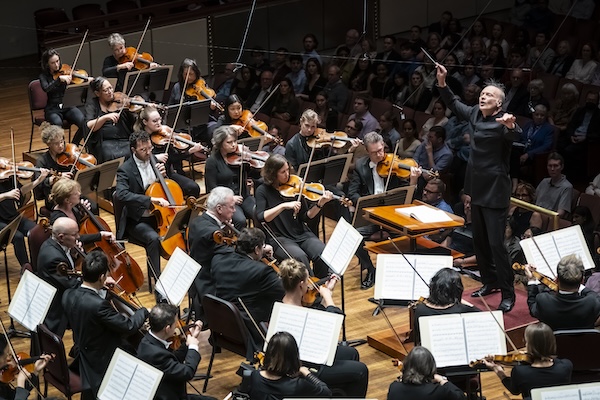Fast and furious: a Mahler 7 that contains multitudes from Noseda, NSO

Gianandrea Noseda conducted the National Symphony Orchestra in Mahler’s Symphony No. 7 Thursday night at the Kennedy Center. Photo: Scott Suchman
Any performance of Mahler’s Seventh Symphony is to be celebrated. The last time that the National Symphony Orchestra played this murky, eclectic piece, in 2000, Leonard Slatkin was at the podium.
Music director Gianandrea Noseda chose it for his fourth excursion into Mahler with the NSO, heard Thursday night in the Kennedy Center Concert Hall. It has been a busy month for the Italian conductor, returning from his first Ring Cycle in Zurich and followed next week by a concert performance of Verdi’s Otello.
As with his previous Mahler outings with the NSO, such as a pandemic-doomed Fifth in 2020 and a raucous First in 2018, Noseda’s approach often revealed the influence of his Russian training with Valery Gergiev. Tempos tended to be brusque, and the edges of the more neurotic mood shifts felt sharpened. While his interpretation of the Seventh at times felt too rushed at a little under eighty minutes, Noseda managed to make this odd assembly of incongruous ideas sound unified.
The opening of the first movement held dramatic promise, with tense funeral march rhythms on an unstable, inverted B minor chord with an added G-sharp. This slow, deliberate texture provided a dramatic backdrop for the unusual Tenorhorn solo, played on a euphonium by principal trombonist Craig Mulcahy. A couple of prominent splats marred the opening passage, but this crucial part was otherwise rock solid.
The second theme of the faster part of the first movement swooned with Straussian feeling in the lush violin writing. The piece really came alive in the development, opened by soft, crisply articulated trumpet fanfares. The trumpet also sounded bright and bold on the ascending theme of consecutive perfect fourths (a musical idea echoed by Star Trek composers Alexander Courage and Jerry Goldsmith).
The dramatic swoosh of the harps ushered in the rapturous B major section, the first movement’s most transcendent moment. Noseda swept away these more introspective passages with a percussion-heavy conclusion that felt a bit bloodthirsty.
The central three movements of this symphony are its heart, two “Night music” sections around a shadowy Scherzo, earning the piece the nickname “Song of the Night,” although it was never used by Mahler. The second movement opened with horn calls, Abel Pereira’s unmuted instrument answered by one that was muted to sound like it was off in the distance.
When this motif returned later, it was accompanied by offstage Herdenglocke, the ethereal cow bells often heard in the Alps, where Mahler spent the summers while composing this symphony. The combination of instruments used, according to percussionist Eric Shin, was “smaller tinkling bells played in the right hand, and larger bells struck at random to give a sense of a herd of animals in the Austrian pasture.” The effect in the hall was perhaps not loud enough but still magical.
Buzzing woodwinds evoked insects and night birds, answered by rattling percussion and scratchy string sounds. Much of the piece has the feel of a funeral march, set in C minor, which Noseda’s edgy tempo pushed too fast. The middle section purred, with its combination of soft harps and woodwinds, before a rousing return to loud and full textures.
The third movement opened with pleasing hesitation, but Noseda settled on a fleet pacing that did not quite suit Mahler’s marking (“Fluent, but not fast”). The balances and dynamics were admirably restrained, giving the sense of something skulking in the darkness. Noseda and the NSO had their best moments in the fourth movement, a moonlit serenade, made sentimental with snatches of folksy sound from the mandolin and guitar played by Neil Gladd and Jim Roberts, respectively.
The concluding Rondo-Finale is, by design, a crazy hodge-podge, which some conductors have even mocked as vulgar. Noseda embraced the work’s contradictions and broad comic strokes. The opening timpani and brass salvos set a brash tone, alternating with gentle episodes and puzzling operatic allusions. Mahler throws everything in his huge battery at the wall, from janissary cymbals and triangle to the cowbells, now on stage and combined with jangling tubular bells. Just when the piece seems to get hung up, on a confused augmented chord, Mahler adjusted the harmony to plain old C major with a final blast.
Mahler’s Symphony No. 7 will be repeated 11:30 a.m. Friday and 8 p.m. Saturday. kennedy-center.org

Posted Jun 02, 2024 at 12:06 am by Cory Jorgensen
I went to the Saturday performance, and I agree with everything you said, unfortunately right down to the baritone player cracking the SECOND note of his solo in the second measure of the piece (oy vey!). It was hard to enjoy the 4th movement at such a brisk tempo. Other than that, it was wonderful. The first and fourth movements were maybe close to the best I’ve ever heard (minus said cracked note).